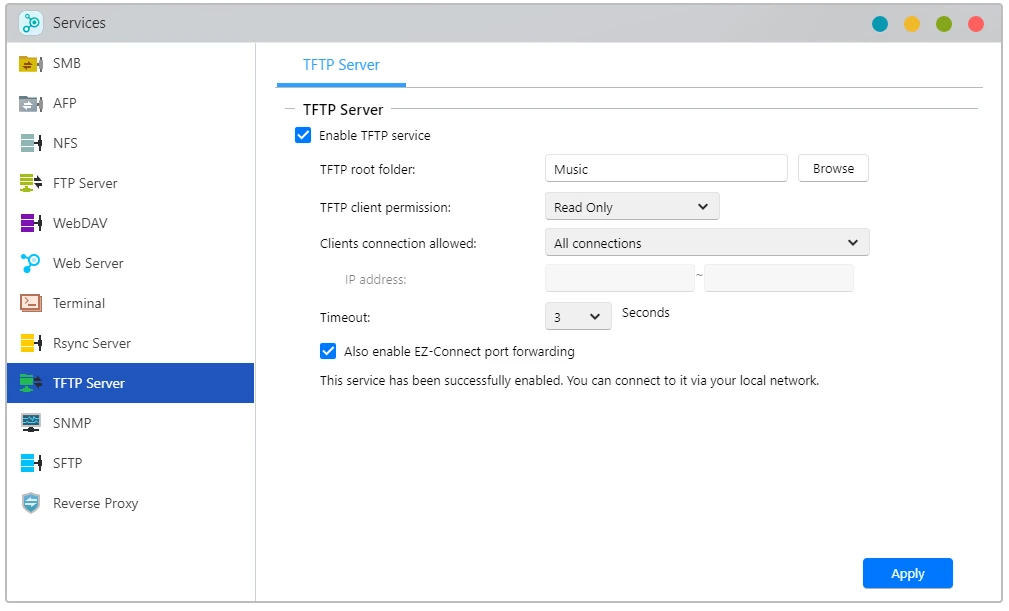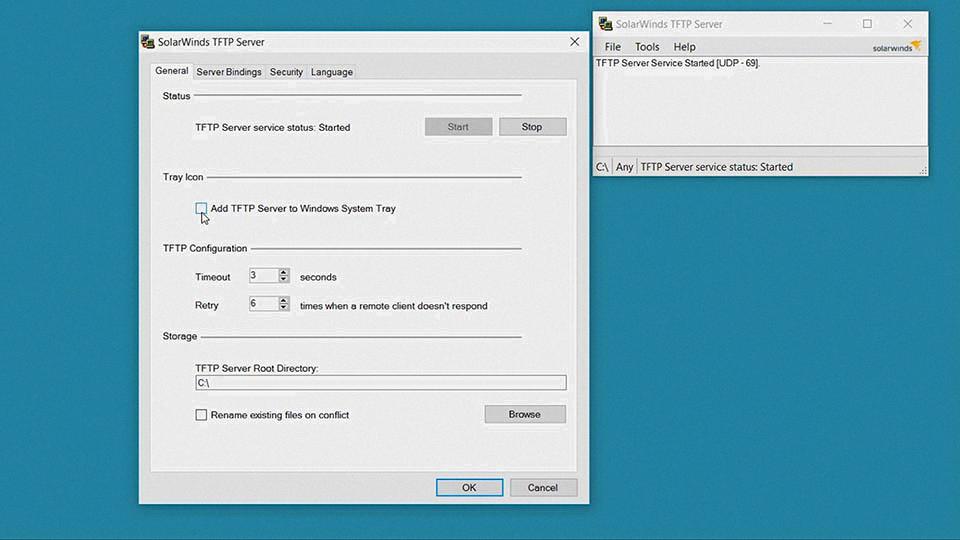A TFTP (Trivial File Transfer Protocol) server is a network-based application designed to allow users to transfer files between two computers over a network. It is commonly used for booting and transferring files, such as configuration files, images, and firmware updates. It is considered an easy-to-use alternative to FTP (File Transfer Protocol) because it does not require authentication or encryption and has very limited capabilities.
There are multiple benefits to using a TFTP server. The primary benefit is its simplicity; it only requires the sending and receiving of files without the need for additional features like encryption or authentication which can make FTP more complicated. Its limited capabilities also mean that it’s more lightweight than other file transfer protocols, making it faster and more efficient when transferring large files across networks. Additionally, using a TFTP server makes remote management easier as users can quickly send configuration files to devices on their networks without having to physically connect them. This makes managing multiple devices much simpler for IT administrators.
A typical TFTP server works by listening for incoming requests from clients on port 69. When it receives the request, the server then sends back any requested data or file contents from its own local repository or another specified location. The client can then use this data or file contents in order to complete whatever task was requested in the first place.
There are many different types of popular TFTP servers available today, ranging from open-source solutions like TFTPD64 and WinAgentsTFTP Server to commercial options like SolarWinds and WhatsUp Gold’s TFTP Server. Each one offers unique features that make them better suited for particular tasks; some are better at handling large file transfers while others offer advanced security features such as authentication and encryption. Ultimately, selecting the right one depends on your individual needs and the environment in which you plan on using it.
setting up a TFTP server can be an effective way to quickly transfer data between computers over networks without needing complex configurations or additional features that might slow down performance or require extra resources on your part. With so many options out there today, finding one that fits your needs should be relatively simple – just be sure to research each option thoroughly before making your final selection!

The Benefits of Using a TFTP Server
A TFTP server is a type of network server that provides the Trivial File Transfer Protocol (TFTP) service. It enables users to transfer files between two TCP/IP machines in a straightforward, uncomplicated way. It is typically used for boot-loading remote devices, although it can also be used to transfer any type of file between two computers. The protocol is quite simple, but limited in its capabilities compared to other more complex protocols such as FTP and SFTP. The TFTP server provides a basic set of commands for sending and receiving files, and the user must manually configure their own client software in order to use the service. Additionally, all data transferred using TFTP is unencrypted and therefore vulnerable to potential security threats.
Differences Between FTP and TFTP
FTP (File Transfer Protocol) and TFTP (Trivial File Transfer Protocol) are both standards for transferring files between two systems. The main difference between them is the complexity of their implementations and the range of features they offer.
FTP is a full-featured protocol that provides comprehensive control over file transfers, including support for directory listings, file permissions, access control, encryption, data compression, error checking and reporting, and much more. FTP clients can be used to manage large file transfers across different systems in an efficient way.
TFTP is a simpler file transfer protocol than FTP. It does not provide any of the features of FTP such as authentication or encryption, but it does support basic operations such as downloading and uploading files. As a result, TFTP requires fewer computing resources than FTP and can be used in situations where performance or bandwidth is limited. Additionally, TFTP is commonly used to boot diskless workstations or servers over a network as it allows files to be transferred quickly without taking up too much bandwidth.
Choosing the Best TFTP Server
The best TFTP server is ultimately dependent on the user’s needs. If you are looking for a simple, free, and easy-to-use server, then TFTPD64 may be the best option. It is an open-source server that runs on both Windows and Linux, making it accessible to a wide range of users. It also has an intuitive graphical user interface that allows for quick setup and management.
If you need a more comprehensive TFTP server with advanced features, then SolarWinds TFTP Server is worth considering. This commercial product offers a comprehensive set of features such as advanced security settings, logging capabilities, and support for multiple simultaneous transfers. Additionally, SolarWinds offers free technical support for its products.
WhatsUp TFTP Server is another great choice if your needs are basic. It is a lightweight solution that offers a simple interface but still supports encryption and authentication settings. It also has the advantage of being completely free to use without any limitations or restrictions on file size or transfer speed.
Ultimately, the best TFTP server will depend on your specific needs. Each of these servers offers different features and benefits so it’s important to consider which ones are most important to you before making your decision.
Transferring Files Using TFTP
To transfer files using TFTP, you will first need to connect to the host where the file is located. This can be done by entering ‘tftp’ followed by the IP address or hostname of the remote host into a terminal window. Once connected, you should see a prompt that reads ‘tftp>’. At this prompt, you can enter the ‘get’ subcommand along with the name of the file that you wish to transfer. For example, if you wanted to transfer a file called ‘update’ from a remote host located at 192.168.1.2, you would type ‘get update 192.168.1.2’. The /home/alice directory on the remote host must have read permission set for others in order for this command to work successfully. After entering this command, your local machine should begin downloading the file from the remote host and once complete it will be available in your local filesystem for use.

Source: solarwinds.com
Comparing TFTP and SFTP
TFTP (Trivial File Transfer Protocol) is a very basic file transfer protocol used mainly for automated file transfers between systems on a local area network. It offers simple and fast data transfer but lacks all the security and management capabilities of FTP (File Transfer Protocol). Unlike FTP, TFTP does not encrypt data and cannot authenticate users, meaning it is not suitable for transferring sensitive information.
SFTP (Secure File Transfer Protocol) is an extension of the standard FTP protocol that provides enhanced security by encrypting both commands and data with strong algorithms. It also adds the ability to authenticate users, allowing access to only certain files to be granted. SFTP also supports the use of public-key cryptography which makes it more secure than traditional FTP. In addition, it includes features such as directory listing and file renaming, making it much easier to manage files on remote systems.
The Best Free TFTP Server
The best free TFTP Server available is SolarWinds TFTP Server. This powerful, yet easy-to-use tool provides users with fast and reliable file transfers across multiple platforms. It is highly secure with several levels of authentication and encryption, as well as flexible configuration options to suit the needs of any organization. Its popularity is due in part to a wide range of features, such as support for IPv6, multicast transfers, and server-side logging. Additionally, it offers an intuitive user interface that makes it easy to set up and manage even complex operations. As a free solution, SolarWinds TFTP Server offers excellent value for money.
Setting Up a TFTP Server
Setting up a TFTP server on Linux is fairly straightforward. First, open the TFTP configuration file located in the /etc/xinet.d directory. Next, add the -c option to the server_args argument in this file. After making changes to the configuration file, save and close it. Finally, restart the TFTP server using the command /etc/rc.d/init.d/xinetd restart. Once this is done, your TFTP server should be up and running!
Conclusion
In conclusion, TFTP is a very useful tool for transferring files between two TCP/IP machines. It is a much lighter protocol than FTP and is used when a file transfer functionality is needed without the advanced features of FTP. TFTP servers allow users to connect and send/receive files with ease. The best TFTP Servers are TFTPD64, Spiceworks TFTP, SolarWinds TFTP, Windows TFTP Utility, WinAgents TFTP Server, WhatsUp TFTP Server and ATFTPD. So if you ever need to transfer files from one machine to another, be sure to look into using a reliable and secure TFTP server!








